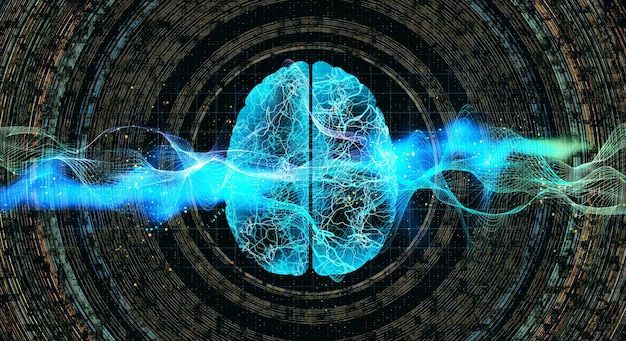Binaural Beats for Focus: Unlocking Productivity in 2025

Binaural beats, auditory illusions created by presenting slightly different frequencies to each ear, show promise as a non-invasive tool to potentially enhance focus and productivity by influencing brainwave states, though individual results can vary depending on proper application and neurological receptivity.
In the relentless pursuit of productivity, modern professionals often seek innovative solutions to sharpen their concentration amidst daily distractions. One intriguing avenue gaining considerable attention is the use of binaural beats to unlock 25% more focus during your workday in 2025. This technology, rooted in auditory science, proposes a novel way to influence brainwave activity and, consequently, cognitive states. But can simply listening to specific frequencies genuinely transform our ability to concentrate?
Understanding Binaural Beats: The Science Behind the Sound
Binaural beats are fascinating auditory illusions that occur in the brain when two different pure-tone sine waves, with frequencies differing by a small amount, are presented to a listener—one tone to each ear. The brain then perceives a third frequency, which is the difference between the two tones. For example, if a 400 Hz tone is played in one ear and a 410 Hz tone in the other, your brain detects a 10 Hz “binaural beat.” This perceived beat is not an external sound, but rather an internal neurological phenomenon.
The core concept behind the use of binaural beats for focus lies in the phenomenon known as “brainwave entrainment.” This suggests that brainwaves tend to synchronize with external rhythmic stimuli. By exposing the brain to a binaural beat frequency that corresponds to a desired brainwave state (e.g., delta for sleep, theta for meditation, alpha for relaxation, or beta/gamma for concentration), the belief is that the brain will gradually align with that frequency, inducing the associated mental state.
The Neurological Basis for Entrainment
The human brain operates on various electrical frequencies, commonly categorized into distinct wave states: Delta, Theta, Alpha, Beta, and Gamma. Each is associated with different states of consciousness and cognitive function. For instance, high-frequency beta waves (13-30 Hz) are typically linked to active concentration, problem-solving, and alertness, while gamma waves (30-100 Hz) are implicated in higher-order processing and heightened awareness. The goal with binaural beats for focus is often to encourage the brain into these higher-frequency states.
- Delta (0.5-4 Hz): Deep sleep, restorative processes.
- Theta (4-8 Hz): Deep relaxation, meditation, creativity, light sleep (REM).
- Alpha (8-13 Hz): Relaxed wakefulness, calm alertness, pre-sleep.
- Beta (13-30 Hz): Active concentration, problem-solving, cognitive tasks, alertness.
- Gamma (30-100 Hz): High-level cognitive processing, learning, memory, perception.
Researchers theorize that binaural beats can non-invasively guide the brain towards these specific frequencies, thereby enhancing or inducing the corresponding mental state. This mechanism bypasses the need for external stimuli at the desired frequency, as the brain itself generates the “beat” internally, allowing for a more subtle and perhaps more effective entrainment process.
The potential for binaural beats to influence brainwave activity has sparked considerable interest in diverse fields, from sleep therapy to pain management, and more recently, in cognitive enhancement strategies. The non-pharmacological nature of this technique makes it an attractive option for those seeking natural ways to optimize their mental performance.
Research and Evidence: Separating Fact from Fiction
The scientific community has explored binaural beats for decades, yielding a mixed but generally promising body of research. While anecdotal evidence abounds regarding their efficacy, rigorous, large-scale studies are still emerging. Early studies often focused on qualitative reports of relaxation or improved sleep. More recent investigations are attempting to quantify the impact on specific cognitive functions like attention and memory.
A notable challenge in this research is the subjective nature of focus and concentration. Measuring a 25% increase in focus, as posed by our central question, is notoriously difficult. Researchers typically rely on standardized cognitive tests, self-reported metrics, and neurophysiological measurements (like EEG scans) to assess changes in brain activity and performance.
Key Findings from Scientific Studies
Some studies have demonstrated that listening to binaural beats can indeed alter brainwave patterns, moving them towards the target frequencies. For example, exposure to beta-frequency binaural beats has been linked to improvements in sustained attention and alertness. Other research suggests alpha-frequency beats may enhance creativity and reduce anxiety, indirectly supporting focus by minimizing distractions.
- Enhanced Alertness: Research indicates that higher frequency binaural beats (beta/gamma range) can lead to increased vigilance and reduced reaction times, consistent with a state of heightened alertness.
- Improved Memory Recall: Certain studies suggest a potential link between specific binaural beat frequencies and improved working memory and immediate recall.
- Reduced Anxiety: While not a direct measure of focus, reduced anxiety levels mediated by alpha or theta binaural beats can create a more conducive environment for concentration.
However, it’s crucial to acknowledge the limitations. Many studies are small-scale, and some suffer from methodological inconsistencies. The “placebo effect” is also a significant factor; simply believing that binaural beats will work can sometimes influence perceived outcomes.

Moreover, individual variability plays a substantial role. Not everyone responds to binaural beats in the same way, or with the same intensity. Factors such as prior listening experience, individual brain chemistry, and even the quality of the audio equipment can influence effectiveness. Therefore, while evidence supports the notion that binaural beats can influence brain states, claiming a precise “25% more focus” for everyone remains an ambitious, unsubstantiated figure in 2025.
Practical Application: How to Use Binaural Beats for Focus
If you’re considering integrating binaural beats into your workday, understanding the practical aspects is essential. The effectiveness largely depends on proper application, consistency, and a realistic understanding of what to expect. This isn’t a magic button, but rather a tool to potentially support your existing focus techniques.
Choosing the Right Frequencies and Setup
For enhancing focus and concentration, the most commonly recommended binaural beat frequencies fall within the beta (13-30 Hz) and gamma (30-100 Hz) ranges. Beta waves are associated with active states of consciousness, problem-solving, and decision-making, while gamma waves are linked to higher-level cognitive processing, intense focus, and memory recall.
- Beta Frequencies (13-30 Hz): Ideal for tasks requiring high concentration, analytical thinking, and alertness. Can help maintain attention during complex work.
- Gamma Frequencies (30-100 Hz): Often used for peak performance, intense focus, and creative problem-solving. Some users report enhanced clarity and insight.
To experience binaural beats effectively, over-ear stereo headphones are crucial. This ensures that a distinct tone is delivered to each ear without blending before reaching the eardrums. Basic earbuds may not always provide the necessary separation. Also, ensure the beats are clean, ideally embedded in a calming background sound (like ambient noise or nature sounds) to make them less intrusive and more pleasant to listen to. Pure, standalone binaural beats can sometimes be irritating.
Integrating into Your Workday Routine
The “when” and “how long” are also critical. Many users find success by listening to binaural beats during specific periods of their workday when focus is most needed. This could be during a dedicated deep work session, while tackling a complex report, or when preparing for an important meeting.
Start with shorter sessions, perhaps 15-30 minutes, to see how you respond. Gradually increase the duration if you find it beneficial. Consistency is key; integrating binaural beats into your regular routine can help train your brain. Avoid listening during tasks that require critical external listening, like phone calls or team collaborations.
It’s important to approach binaural beats as a supplementary tool rather than a standalone solution. Combine them with other proven focus techniques, such as the Pomodoro Technique, regular breaks, a clutter-free workspace, and sufficient sleep. Setting clear intentions before listening can also amplify the perceived benefits.
Potential Benefits Beyond Focus: A Holistic Approach
While our central question revolves around focus, the alleged benefits of binaural beats extend into adjacent cognitive and emotional domains. A holistic approach to wellbeing often underpins sustained focus, suggesting that improvements in related areas can indirectly enhance one’s ability to concentrate during the workday. This broader impact is part of what makes binaural beats an interesting subject for personal optimization.
Beyond direct cognitive enhancement, researchers and anecdotal reports highlight several other areas where binaural beats may offer advantages. These benefits often create a more conducive mental state for productivity by reducing common barriers to concentration, such as stress and poor sleep quality.
Reducing Stress and Anxiety
One of the most frequently cited benefits of binaural beats, particularly those in the alpha and theta ranges, is their potential to induce states of relaxation. By guiding brainwaves towards these slower frequencies, individuals often report a reduction in feelings of stress and anxiety. A calm mind is inherently more capable of focusing on tasks at hand, as the internal noise of worries and distractions is minimized. This stress reduction can be a powerful indirect aid to concentration.
- Alpha Waves: Promote a state of calm alertness, ideal for light work or preparation.
- Theta Waves: Associated with deep meditation and relaxation, which can help clear the mind before or after intense focus sessions.
Integrating these frequencies for brief periods during breaks can serve as a mental reset, helping to maintain a steady state of calm throughout a demanding workday. This preventative measure against burnout contributes significantly to long-term focus capabilities.
Improving Sleep Quality
Adequate, restorative sleep is a cornerstone of optimal cognitive function, including focus. Binaural beats in the delta frequency range (0.5-4 Hz) are specifically designed to promote deep sleep. By listening to these beats before bedtime, some users report falling asleep more easily and experiencing more profound rest. Better sleep directly translates to improved daytime alertness, memory, and, crucially, sustained focus.
A well-rested brain can process information more efficiently, filter out distractions more effectively, and maintain attention for longer periods without fatigue. The correlation between sleep quality and cognitive performance is well-established, making binaural beats a compelling tool for those struggling with sleep. This directly addresses one of the most fundamental requirements for peak daily focus.
By encompassing these broader benefits, binaural beats offer more than just a direct focus boost; they provide a potential pathway to a more balanced and resilient mental state, ultimately contributing to enhanced productivity in a multifaceted way.
Limitations and Considerations: A Balanced Perspective
While the prospect of harnessing binaural beats for enhanced focus is exciting, it’s crucial to maintain a balanced perspective. Like any emerging technology or wellness tool, binaural beats come with limitations and considerations that users should be aware of. Over-optimistic claims can lead to disappointment, while ignoring potential pitfalls can be counterproductive. A critical approach ensures realistic expectations and safe usage.
Understanding these aspects helps in making informed decisions and integrating binaural beats effectively into a personal routine without over-reliance or misunderstanding their actual capabilities. The human brain is complex, and no single solution works identically for everyone.
Individual Variability and Placebo Effect
One of the primary limitations is the significant degree of individual variability. Not everyone responds to binaural beats with the same intensity, or even responds at all. Factors such as neurological differences, natural brainwave patterns, and even mood can influence how effectively an individual’s brain will entrain to a specific frequency. What works for one person may have minimal effect on another.
Furthermore, the placebo effect cannot be underestimated. The belief that a treatment or intervention will work can often produce real physiological and psychological changes, even if the intervention itself has no inherent power. Given the subjective nature of focus and concentration, it’s challenging to isolate the direct effect of binaural beats from the user’s positive expectations. Users may attribute improvements solely to the beats when other factors, including their own mindset, are equally or more influential.
Lack of Robust Long-Term Studies
Despite growing interest, the body of high-quality, long-term scientific research on binaural beats is still evolving. Many existing studies are small-scale, short-duration, or suffer from methodological limitations. There’s a notable absence of large-scale, double-blind, placebo-controlled trials necessary to conclusively determine the efficacy for specific cognitive enhancements over extended periods. Questions remain regarding optimal frequencies, duration of listening, and potential impacts of prolonged use.
Without this robust evidence, claims of a precise “25% increase in focus” should be viewed with skepticism. While preliminary research is promising, the scientific community typically requires more comprehensive data before making definitive conclusions about such specific outcomes.

Lastly, while generally considered safe, individuals with certain neurological conditions, such as epilepsy, or those who wear pacemakers, should consult a healthcare professional before experimenting with binaural beat stimulation. The auditory nature also means they might not be suitable for all work environments or for individuals with hearing impairments. These considerations underscore the importance of a cautious and informed approach when exploring binaural beats as a tool for cognitive enhancement.
Integrating Binaural Beats with Other Focus Techniques
For binaural beats to truly contribute to enhanced focus, particularly aiming for significant gains like 25% improvement, they are best utilized as part of a comprehensive strategy. Relying solely on auditory stimulation without addressing other aspects of productivity and well-being might yield limited results. Think of binaural beats as an amplifier for existing good habits, rather than a standalone solution.
The most effective approach combines technological aids with established psychological and environmental strategies. This synergy creates a robust framework for sustained concentration and higher quality work output. Focusing on a “stack” of techniques ensures that if one method has a subtle effect, others can pick up the slack.
The Power of a Synergistic Approach
Combining binaural beats with traditional focus techniques can create a more powerful and resilient state of concentration. For instance, incorporating them into a Pomodoro Technique session can deepen the focused work blocks. During the 25-minute work intervals, listening to beta or gamma binaural beats might help cement your attention on the task, while brief silent breaks or alpha/theta beats during longer breaks could promote mental recovery.
- Mindfulness and Meditation: Regular mindfulness practice, even for 5-10 minutes daily, trains the brain to stay present and reduces mind-wandering. Binaural beats (especially alpha or theta) can be a great aid for meditation, preparing the mind for focused work.
- Structured Work Environment: Minimizing physical and digital distractions is paramount. A clean workspace, turning off notifications, and using website blockers create an optimal environment where binaural beats can truly shine, rather than fighting against constant interruptions.
The key is to experiment and find what combination works best for your individual workflow and cognitive patterns. Some people might prefer listening to binaural beats throughout their entire deep work session, while others might use them only for the first 15 minutes to kickstart focus.
Prioritizing Holistic Well-being
No amount of technological intervention can fully compensate for poor foundational habits. For sustained focus and cognitive performance, foundational lifestyle elements are critical. This includes adequate sleep (7-9 hours per night), a balanced diet rich in whole foods, and regular physical activity. These elements directly impact brain health, neurotransmitter balance, and energy levels, all of which are prerequisites for optimal concentration.
Hydration is also a simple yet often overlooked factor in cognitive function. Even mild dehydration can impair attention and processing speed. Integrating short breaks, stretching, and eye exercises during long periods of screen time can also prevent fatigue and maintain cognitive stamina. By viewing binaural beats as part of a broader commitment to personal well-being and productivity habits, individuals are far more likely to experience meaningful improvements in their focus. In 2025, holistic personal management will remain the gold standard for peak performance.
The Future of Focus: What to Expect by 2025 and Beyond
As we approach 2025, the landscape of cognitive enhancement, particularly concerning focus, is rapidly evolving. Binaural beats, while not new, are part of a broader trend towards non-invasive brain stimulation and neurofeedback techniques. The integration of artificial intelligence (AI) and wearable technology is poised to revolutionize how we understand, optimize, and potentially enhance our cognitive states.
The quest for a 25% increase in focus is ambitious, but the convergence of technology and neuroscience suggests that personalized and precise solutions may become more accessible. While a universal “one-size-fits-all” solution remains unlikely, individualized approaches tailored to unique brain patterns hold significant promise.
Personalized Neuro-Optimization
The future likely holds highly personalized neuro-optimization tools. Imagine wearable devices that monitor your brainwave activity in real-time, detecting fluctuations in focus or the onset of fatigue. These devices could then dynamically adjust binaural beat frequencies or introduce other auditory cues (e.g., adaptive music) to subtly guide your brain back to an optimal state for concentration. AI algorithms would learn your unique brain patterns and preferred stimuli, creating truly bespoke soundscapes for productivity.
This level of personalization goes beyond generic binaural beat tracks. It would involve sophisticated biofeedback loops, where your brain’s response is continually analyzed, and the auditory input is refined to maximize entrainment efficacy. This could significantly improve the consistency and magnitude of focus enhancement compared to current methods.
Integration with Digital Workflows
By 2025, binaural beat technology could be seamlessly integrated into common digital collaboration and productivity platforms. Imagine your project management software detecting an impending deadline and automatically suggesting a focus-enhancing binaural beat playlist. Or, your video conferencing tool could offer a “focus mode” that subtly plays specific frequencies designed to keep you engaged during long meetings.
Audio hardware itself will also likely evolve. Headphones could feature advanced sensors for brainwave monitoring, automatically adjusting their output based on your current mental state or task requirements. This seamless integration would make using such tools effortless, removing any friction that might prevent consistent use and widespread adoption.
However, ethical considerations and data privacy will become paramount. Understanding how our brain data is collected, used, and protected will be critical. The industry will need to establish clear guidelines to ensure these tools enhance, rather than compromise, our well-being and autonomy. While a 25% focus boost for everyone by 2025 is a bold prediction, the trajectory of neurotechnology suggests that significant, measurable improvements in personal cognitive performance are increasingly within reach.
| Key Aspect | Brief Description |
|---|---|
| 🧠 How it Works | Brain perceives a “beat” from two different tones, influencing brainwave states (entrainment). |
| 🔬 Scientific Evidence | Promising small-scale studies on alertness and memory, but large-scale evidence is still developing. |
| 🎧 Best Use | Stereo headphones, beta/gamma frequencies for focus, integrated with other productivity methods. |
| ⚠️ Key Considerations | Individual variability, placebo effect, and consulting professionals for certain health conditions. |
Frequently Asked Questions About Binaural Beats and Focus
Binaural beats are auditory illusions created when two slightly different frequencies are played, one in each ear. Your brain perceives a third “beat” frequency, which proponents claim can entrain brainwaves to desired states, such as beta or gamma for enhanced focus and concentration during tasks.
Yes, for enhanced focus and concentration, beta frequencies (13-30 Hz) are most commonly recommended, as they are associated with active states of alertness and problem-solving. Gamma frequencies (30-100 Hz) are also used for high-level cognitive processing and intense concentration, offering potential benefits.
While binaural beats show promise, there is no scientific consensus or robust clinical evidence that guarantees a precise 25% increase in focus for everyone. Individual responses vary greatly due to neurological differences and the influence of the placebo effect. They are best viewed as a potential aid.
To experience binaural beats effectively, a good quality pair of stereo headphones (preferably over-ear) is essential. This ensures that the distinct tones are delivered separately to each ear, allowing the brain to accurately perceive the binaural beat frequency without interference.
Absolutely. Binaural beats are often most effective when integrated with established productivity methods like the Pomodoro Technique, mindfulness practice, and maintaining a distraction-free environment. They can amplify the benefits of these techniques, rather than serving as a sole solution for all focus needs.
Conclusion
The intriguing potential of binaural beats to influence brainwave states and enhance focus points to an exciting frontier in cognitive optimization. While the bold claim of unlocking a universal 25% more focus by 2025 remains scientifically unproven, the growing body of research, combined with strong anecdotal reports, suggests a significant role for these auditory tools. Their non-invasive nature and accessibility make them a low-risk option for individuals seeking to sharpen their concentration in an increasingly distracting world. The key to maximizing their benefits lies in a balanced approach: understanding the science, selecting appropriate frequencies, integrating them thoughtfully into a broader routine of productivity and well-being strategies, and maintaining realistic expectations. As technology evolves, personalized applications and seamless integration into our digital lives may very well make binaural beats a more powerful and widespread tool for achieving heightened concentration, contributing to a more focused and productive workday in the years to come.





